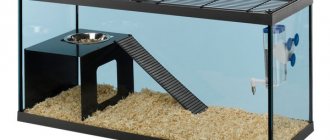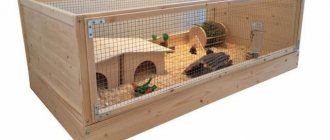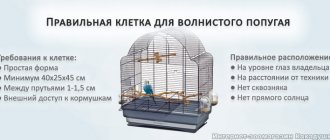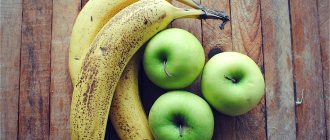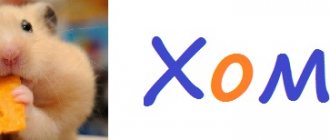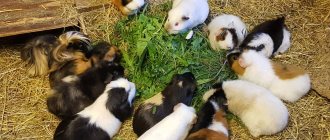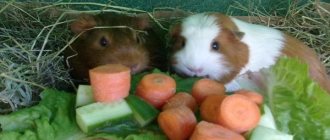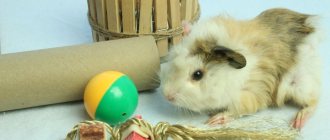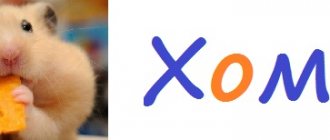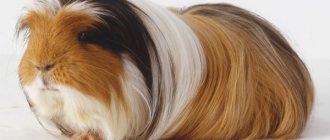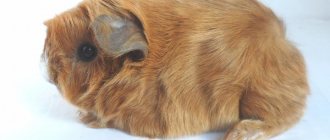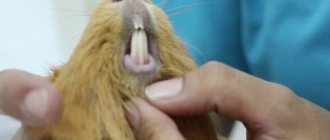Material of manufacture
The catalog of cages for animals presents different options, but many are not even worth considering. A bad material for keeping a guinea pig is wood. Although such cells look beautiful, they absorb dirt and odors. The rodent happily sharpens its teeth on wooden beams, destroying the cage.
Often in a pet store they try to force a terrarium or an aquarium on the buyer. The main argument is that dirt and sawdust will not fly into the room. But in such containers there is no ventilation. The animal will breathe fumes from excrement. In addition, the guinea pig’s brain is designed in such a way that the animal does not see what is happening behind the glass, and in such a house it will feel lonely.
Popular sections:
Aquariums Sale of kittens and puppies Terrariums Products for cats Products for dogs
The optimal composition of the cage is a plastic tray and metal rods. Such houses are durable, resistant to moisture, easy to wash and do not collapse under the influence of disinfectants.
What types of cages are there for guinea pigs?
A guinea pig cage can be in the form of an aquarium or terrarium, dune or lattice. But are all types of cages suitable for keeping rodents?
Aquarium
This type of home is a rectangular glass container. Tightly closed walls prevent scattering of filler around the animal’s “apartment” and drafts. But in such a home there is no air ventilation. Animals breathe stale air, pet feces emit a stench, and harmful bacteria multiply faster, which leads to animal diseases.
Therefore, this type of housing is not recommended for pigs.
Dune
Such a home looks more like a plastic container. Its upper part is made with a lattice door, the lower part is blank. The advantages of this type include: cleanliness around the cage, mobility.
Disadvantages: lack of sufficient ventilation, modest size.
A dune-type device is convenient for taking your animal to the veterinarian or for moving. But for permanent housing for the animal, a more spacious option is needed.
Cell
A pig cage is the most suitable option, as it consists of a plastic tray with high walls and a lattice top. The fact that the walls and roof of this type of housing are lattice allows the air inside the cage to constantly circulate. Hammocks, nipple drinkers, and salt stones are also attached to the grates. The disadvantages of such housing include debris around the cage, inconvenience of carrying, and small size.
Aviary
Another type of housing is an enclosure for a guinea pig. Enclosures are fences that limit a certain area. The walls of the enclosure can be made of wood or metal lattice. Such structures do not have a roof or a pallet. Enclosures are good because they have good air ventilation, they can be assembled into the desired shape, and they can be made with your own hands. The walls of such devices must be at least 40 centimeters.
Pet stores sell cages for birds, chinchillas, and hamsters. They are not suitable for pigs. The hamster's housing is too small. The pig will be cramped in such a space and will become depressed.
A two-story cage designed for hamsters and birds is dangerous for pigs. It is difficult for animals to maneuver in such small areas. There is a risk of falling, which can lead to injury to the animal. For pigs, a large cage size is required.
Design
An important point when choosing a cage for a pet is the correct design. You cannot take a cage for birds, hamsters, ferrets or any other pets. Such structures are dangerous for a guinea pig because they are too high and do not have a clear division into floors, and the pet can get injured in them. Remember other useful tips:
- The safe height for the animal is 10-15 centimeters; objects and accessories cannot be placed above this mark.
- Choose houses of rectangular or square shape (the main thing is large width).
- The removable cage cover makes cleaning easy.
- If you have several pets or plan to breed them, choose cages with dividing panels and ramps.
- If you travel frequently, buy a crate that can be disassembled and assembled so you can take your pet with you.
Lack of physical activity
Guinea pigs are neither cats nor dogs. You should not use harnesses or leashes for walking them. Remember that these rodents have a very weak spine. The slightest wrong move and you could break it. At the same time, guinea pigs only seem so clumsy: they are able to outrun even some of their owners in swimming and running.
The good physical shape of these cute animals is the key to their health and good mood. Pigs should have the opportunity and time to jog freely, and sometimes it doesn’t hurt for them to go swimming.
If you don't do this, your pet will be exposed to the same risks that a sedentary person would expose themselves to. For walking, fence off a large space in the room, cover it with diapers and let the pigs out there, just don’t forget to put water, hay, and some edible fresh leaves. It is advisable to carry out such walks daily, but if you are very busy, walk your pigs at least several times a week.
In the summer, such a “stadium” can be set up at the dacha and the pigs can be released to graze, but under supervision. Be careful: neighbor dogs and cats will not stand on ceremony with these cute animals. Make sure there are no harmful or poisonous plants around.
Filler
Filling is placed in the pet's cage, otherwise the animal is at risk of fungus, various types of dermatitis, hair loss and other health problems. This is a necessary part also for the following reasons:
- the animal's paws are adapted to soft surfaces;
- the filler plays the role of a toilet;
- the pig needs to dig and dig for something.
Experts recommend different beddings, each of which has its own advantages and disadvantages.
| Type | pros | Minuses |
| Wood sawdust | They absorb moisture well, soft, inexpensive. | Almost do not absorb odors, often cause allergies |
| PVC mat | Pleasant soft surface, with it the food will lie separately from the filler | Not used separately, there must be filler underneath. There is a risk of poisoning from the substances from which the mat is made. |
| Toilet paper | Sold in any store, soft, does not cause allergies | Impractical, instantly saturated with odor and moisture |
| Absorbent diapers | Convenient to use | Dear ones, they get dirty quickly |
| Hay or straw | Natural natural material | Your guinea pig will quickly eat this stuffing. |
| Fleece | In demand among pig breeders in Europe, it is warm, stays dry for a long time, can be washed and used many times | Also not used separately, only complete with filler. |
Whatever you use, keep in mind that the main rule is that the filler should be as natural as possible, without dyes or toxic additives.
Exercise Handles
If your enclosure doesn't have plenty of space for exercise, your guinea pigs should be given extra space.
A portable wire cage (you can make your own or buy ones made specifically for small animals or dogs) can be used as a pen for guinea pigs and keep them from getting into trouble (climbing under furniture, chewing wires, etc.).
Your guinea pigs can enjoy being outside in warm weather - a wire cage (fully enclosed to protect the guinea pigs) placed on the lawn is a nice change of scenery.
Only do this if you are not using pesticides or fertilizers on your lawn. Water and shade should be available at all times when they are outside.
What do guinea pigs eat?
Food
A healthy diet will prolong the life and improve the health of your pet. Remember the correct diet of the animal:
- hay – 60%;
- vegetable and fruit components, greens – 30%;
- dry food – 10%.
The main product on the animal’s menu is hay. It forms healthy digestion for your pet and supplies it with all the necessary substances and vitamins. The most useful is considered to be hay made from cereals and beans, clover, alfalfa, and nettle. Hay is purchased or prepared independently.
Guinea pigs are primarily herbivores, so the menu should include seasonal fruits and vegetables. Pieces that are not eaten before the next feeding are thrown away. Your pet's daily diet should include at least 5 types of vegetables and herbs. The animal is offered sprouted grains and seeds, branches of trees and shrubs along with leaves and flowers (acacia, birch, maple, poplar). Remember that many plants, such as lilacs, and most indoor flowers are poisonous to guinea pigs.
Food utensils and water bottle
For food, it is better to choose a heavy ceramic bowl. To maintain a supply of clean water, use a water bottle with a steel spout and ball rather than a bowl of water.
Guinea pigs tend to drink a lot (and some play with bottles), so keep an eye on your water supply throughout the day and replenish as needed. A small hay bin can be placed to keep a supply of clean hay to chew on.
The cage will likely need to be cleaned weekly or more often.
Toys
Interesting toys will delight your guinea pig. But owners must remember what items are prohibited from being placed in a rodent’s cage:
- running wheels;
- walking balls;
- rings and bells on ropes.
Guinea pigs are slow and inflexible animals; they have weak spinal muscles. The following items can cause serious injury. Tunnels are great for stimulating physical activity. A good choice would be tennis or ping-pong balls, cubes, and any high-quality toys for leisure and grinding down the rodent's teeth.
Arrangement of the cage
A rodent's home is multifunctional. The arrangement of the cage includes items that will be needed not only for food and rest, but also for active entertainment.
To avoid fights, each pig is given a house. They can be purchased plastic or homemade wooden. The flat roof will serve as an observation post. Instead of stairs, a ramp is installed, which is securely fixed.
The animal's dining room is equipped with feeders for dry grass and grain, and a drinking bowl. It is preferable to install a plastic tank with a tube with a ball valve at the end.
Feeders should be safe: without edges or edges, food residues can be easily cleaned off. The best models are plastic, ceramic, stainless steel, and enameled. Senniki are made from mesh or fabric; they buy ready-made plastic ones that are attached to the walls.
Animals will love a hammock, a soft bed, toys made from natural materials, and a labyrinth with several holes. A hammock can be easily made from a regular towel. The space should not be cluttered; all these attributes are installed if space allows. Free space is also an element of the game where the animal can run and jump.
The rodent loves to roll an ordinary tennis or hard rubber ball. You need to choose a large ball so that it is difficult to chew it.
The animal can try any objects that are used to furnish the cage. Under no circumstances should glass figures be left in the cage. Even a very small chip can cause a dangerous wound to your pig.
To prevent the animal from wanting to spoil things, there should always be dry grass and branches of fruit trees in the hay barn.
Pigs are very shy, but at the same time they easily make contact with other pets. It is possible that the rodent will share a bed in the enclosure with a kitten or puppy.
Bed dress
For bedding, do not use cedar sawdust, and ideally, pine sawdust too. Aspen shavings are an acceptable choice, as is hay (a layer of paper underneath will help with better absorption).
New recycled paper bedding will also work, as will the numerous other types of pet-safe bedding and bedding that are being produced today.
Types of enclosures for pigs
In the summer, experts recommend releasing pigs onto the grass, giving them a little freedom. Ideally, summer residents will be able to do this by taking a portable enclosure with them. If you don’t have money for an enclosure, you can drive small pegs into the ground and stretch a tight mesh. Despite the simplicity of such a structure, an enclosure of this type will not protect your pet from uninvited guests. The greatest danger comes from cats, dogs and birds of prey flying past. If the pig is in an enclosure without a cover on top, it must be under constant supervision.
Enclosures have different internal designs. For the convenience of the animal, you can build tunnels and indoor labyrinths where it can hide from danger. Additions are most often constructed from balsa wood or oak. Bridges can be made from tree bark; they increase the endurance of animals. In the pen itself, you can place additional equipment in the form of toys and other accessories at the owner’s discretion. The floor of the enclosure should be equipped with linoleum or absorbent film. Pieces of an old rug will do. Do not forget that the cage needs periodic cleaning.
Do not give your animal plastic objects, feeders or drinking bowls. Your pet may chew on such objects and injure themselves on the edges of the bitten plastic. Walking for your pet can be organized using a purchased ladder.
Country type enclosure
In the summer, many owners take their pet with them to the dacha in the summer. To make the animal comfortable, you can build a special country-type enclosure. The enclosure is built according to the previously agreed method - stakes are driven into the ground and the net is stretched. You can also pull it on top for greater safety for your pet.
An aviary of a more reliable design is usually made of solid wood. From the outside it looks like a box without a top. It can be attached if you want to protect your pet from uninvited guests like birds of prey, but then you should take care of ventilation. It is distinguished by its spaciousness and proper insulation using special means. The bottom is retractable, which ensures comfortable care by the owners. The surface of the box should be treated a couple of weeks before departure with a protective agent that will prevent rotting and the appearance of various bacteria and putrefaction, and will also protect from moisture.
It is important to remember that you only need to treat the outer part of the enclosure, since the pig may begin to chew on the wood and be poisoned by chemicals. Usually the pen is left in the shade of trees, but if it starts to rain, the pet should be brought into the house
How to arrange it?
Objects inside the home should be well attached to the walls or located on the floor. Inside the cage it is necessary to place a drinking bowl, a feeder, a tray for hay, toys, and wooden sticks. It is also necessary to provide the animal with a place of privacy.
With the help of a drinking bowl, the individual will not splash water onto the litter and will not be able to wet itself. The volume of the drinking bowl may depend on the number of pets inside the cage. If there are a lot of animals, then you can use several small drinking bowls.
There must also be a food area inside the individual’s home. It is necessary to purchase several feeders to sprinkle different types of feed. Green, juicy and tough food should be placed in different feeders.
A rodent that lives at home needs conditions similar to natural ones. The pet needs rough materials so that it can grind down its teeth. You need to put twigs inside the cage, but you shouldn’t put coniferous branches. Branches that have large bones inside the fruits must be dried in advance. You can also put a mineral stone inside the cage.
You can place hanging accessories as they will not cause injury to your pet if they are installed and secured correctly. For example, it is worth taking a closer look at hammocks on which sea pets can relax.
The animal is shy and modest. Next to caring people, the individual will become more sociable and bolder. But your pet still needs an area so that he can have some privacy. Inside the cage you should arrange a secluded corner, for example, a house.
If there are many rodents inside the cage, they will fight for it. Instead of a simple house, you need to put up a canopy or fence the entire cage with good material. Another option is to use a pipe made from compressed hay.
If a guinea pig is constantly hiding inside the house, then it will be impossible to tame it, since inside it the animal may feel isolated and cannot see people. In order for the pet to get used to the person, the house needs to be temporarily replaced with a handful of hay.
You should buy toys for the animal so that your guinea pig can have some fun. With the help of toys, your pet will be able to quickly explore the entire territory of the cage. In order for the animal to move more, you need to constantly change toys.
If you put a ball of hay in a cage, many rodents will be able to pull the straws out of it. But this design will not be convenient for eating. You can put both a special tray and a ball.
These pets feel comfortable in an area that looks like a hole. For this reason, it is necessary to purchase toys that are shaped like a pipe. If several animals live inside the cage, then you need to purchase several pipes. Pipes can serve as a shelter if pets conflict with each other. Also, pipes and labyrinths can make your pet’s life more interesting.
The animal can become interested in various labyrinths for a long time. The main thing is that the rodent is active, as this has a good effect on the pet’s health - it will not become obese.
To learn how to make a cage with your own hands, see below.
What types of enclosures are there?
Enclosures can have different “interiors”. You can make some kind of tunnels and pipes so that the animal can run and hide through them. This is often made from cork oak. Guinea pigs enjoy a variety of bridges. They can be made from bark. Ceramic toys and wicker baskets can be placed in the pen.
It is better to place an absorbent diaper on the floor in the enclosure. Old linoleum will do. You can throw on pieces of an old natural rug. Don’t forget to sanitize all this in a timely manner.
You can organize a walk for your guinea pig using a fence purchased from a pet store.
Popular manufacturers
The modern pet industry offers a variety of cage options for keeping guinea pigs. You can find out how much a product from your favorite company costs on the website or directly at the pet store. Most often you can see products from several manufacturers on sale.
Triol
A well-known Russian company offering a wide range of pet products at affordable prices. Cages for pigs are large enough, comfortable, and functional. The walls are wire, the deep tray is made of colored plastic, and the wide door is located in the ceiling. Some models are additionally equipped with a lattice floor, which protects the pig from dampness and dirt. Reliable, convenient latches allow you to quickly assemble and disassemble the model for cleaning. All rods are covered with durable, pet-safe enamel. The cost of the products is 1.5-5 thousand rubles, depending on the size.
Ferplast
An Italian company that produces high-quality spacious cages made of plastic, metal and wood.
The range includes products on a stand, with a removable bottom for summer installation outside, with additional removable compartments to expand the space, and a two-story cage with a ramp is also offered. Many products are equipped with folding walls-doors, as well as houses-ramps.
The Ferplast CAVIE 80 DECOR cage folds up conveniently and can be used as an aviary
Animal-safe materials are used in production; the rods are painted with a special composition that is resistant to gnawing. The price depends on the size of the models, about 3-5 thousand rubles.
Cage Ferplast CAVIE 80 DOUBLE
Savic
Belgian manufacturer of pet products. Offers wire cages with trays made of high-quality colored plastic, dune containers. The products are easy to assemble using convenient fasteners; the plastic surface is easy to clean and does not absorb odors. Lattice models have folding walls that allow you to open the cage from the side, on both sides. Dune models have a lattice door in the ceiling that allows air to flow in. Thanks to the large size of the cage door, it is convenient to put and take out bowls and take out the pet.
Cage Savic nero 2 deluxe
Italian one-story cages for guinea pigs, with a deep tray and a wire top. The products are made of high quality materials, equipped with a shelf with a convenient ramp, and have hinged doors on the ceiling and sides. The cost of models, depending on the size, is about 4-9 thousand rubles.
Midwest
An American company presents the original Guinea habitat plus cage-aviary. The canvas tray with Velcro is easy to remove and clean.
Cage-aviary Guinea habitat plus
Wire walls can also be used as a pen for walking outdoors or in an apartment; it is also possible to combine two cages together. The ceiling elements are removable and can be used as additional sections for an enclosure or internal dividers. If necessary, delimiters and ramps can also be installed inside the pallet. All sections and elements can be easily disassembled and folded. The cage takes up little space during transportation and storage. The price of such a cage is about 6,000 rubles.
Despite the abundance of ready-made options, pig cages are often made by hand from wood and metal mesh. This is especially convenient in a suburban area, where the pet can walk in an enclosure on fresh grass. Making it yourself also allows you to save money and create a truly spacious home for your pet.
